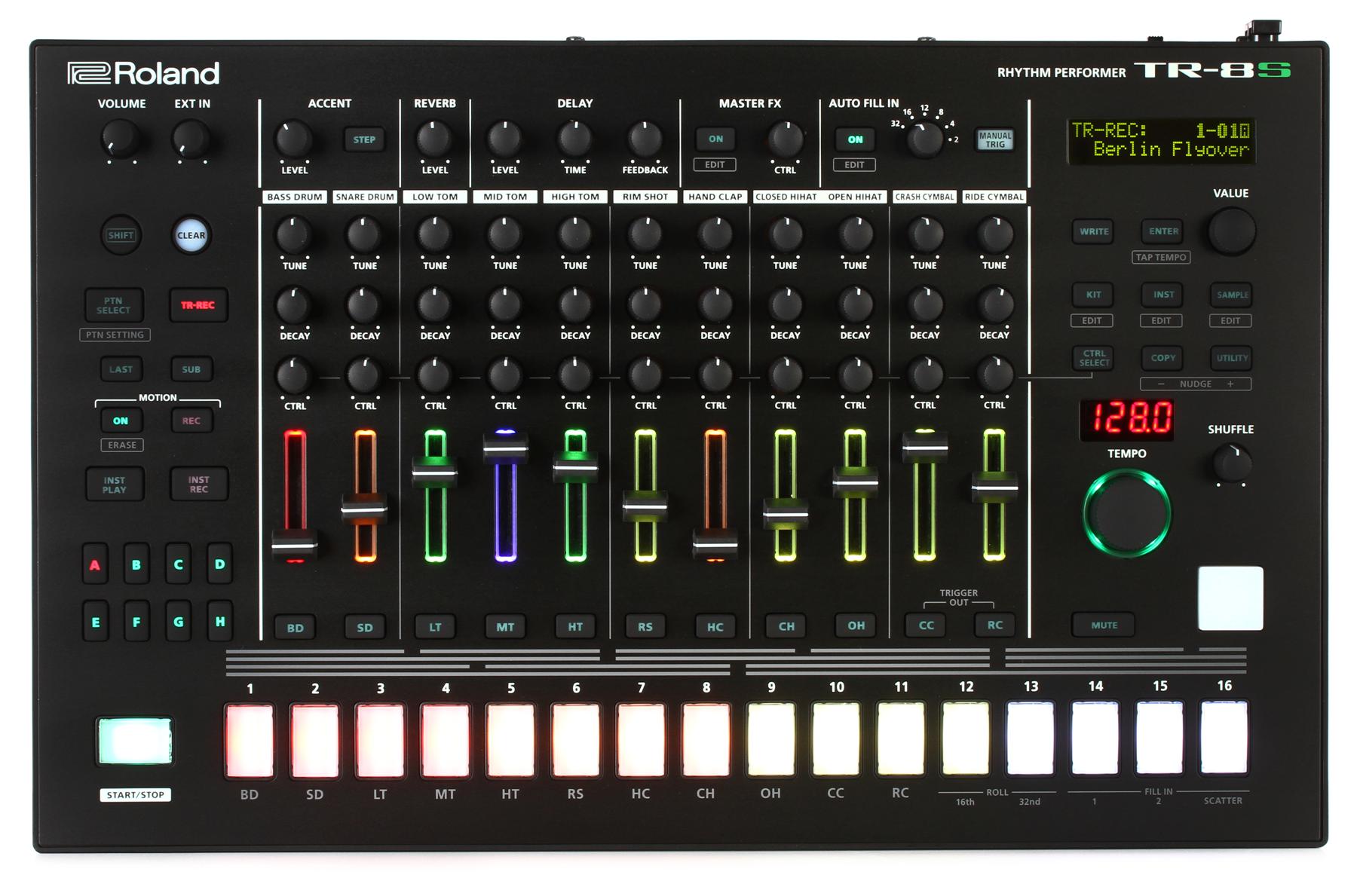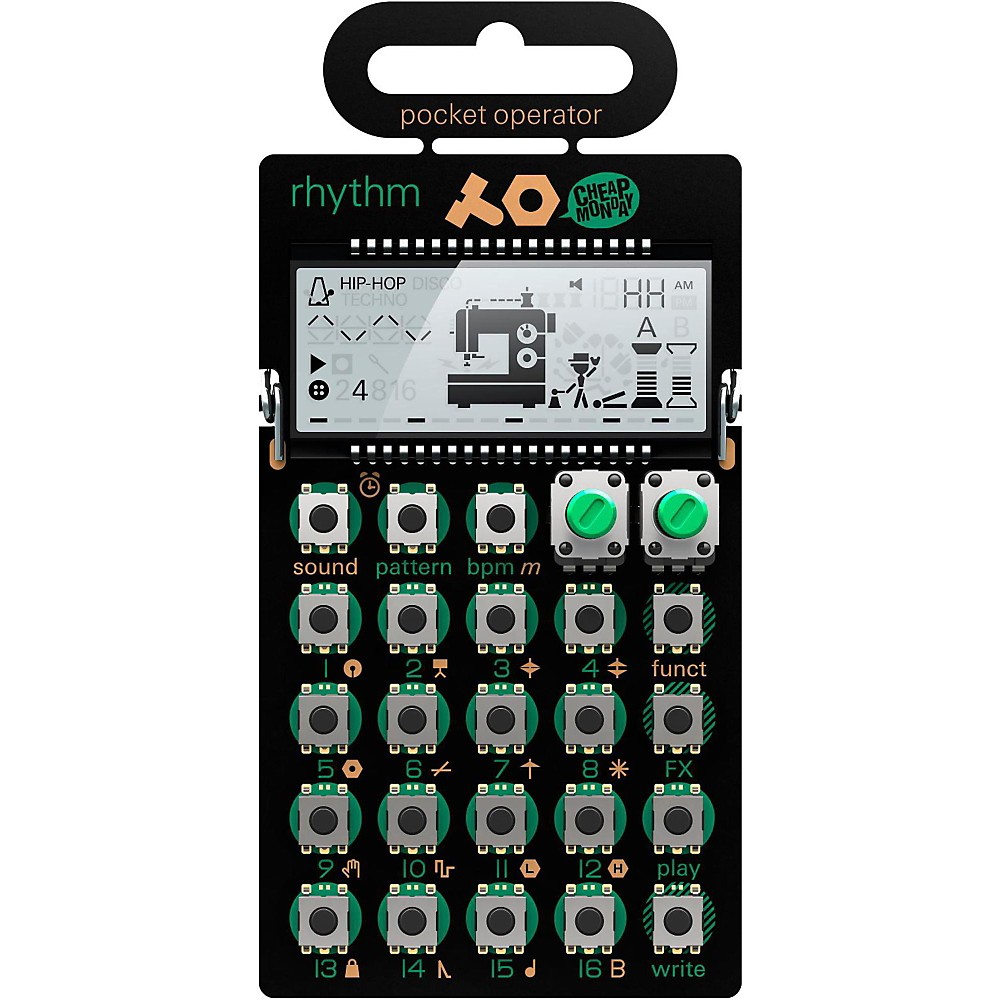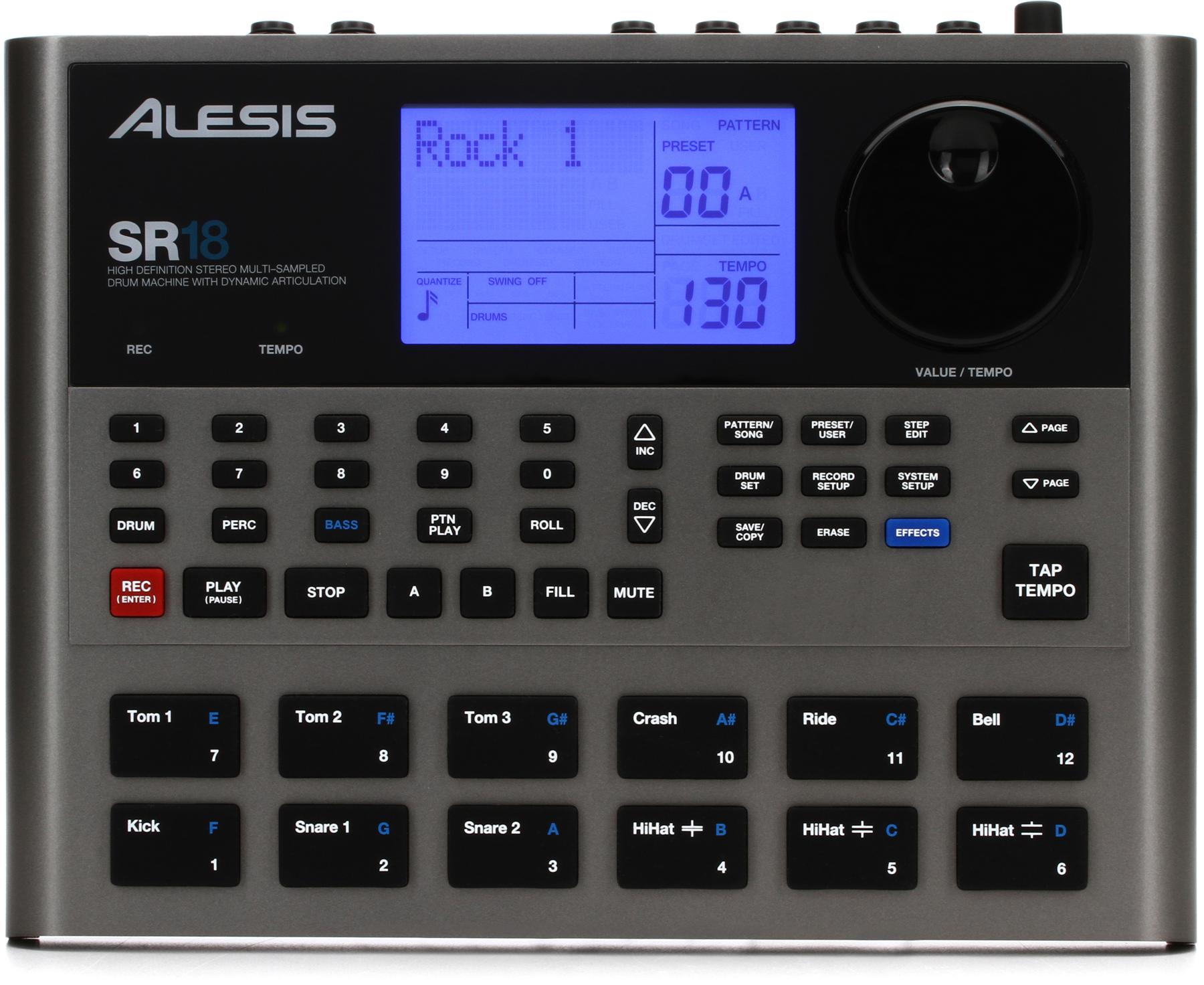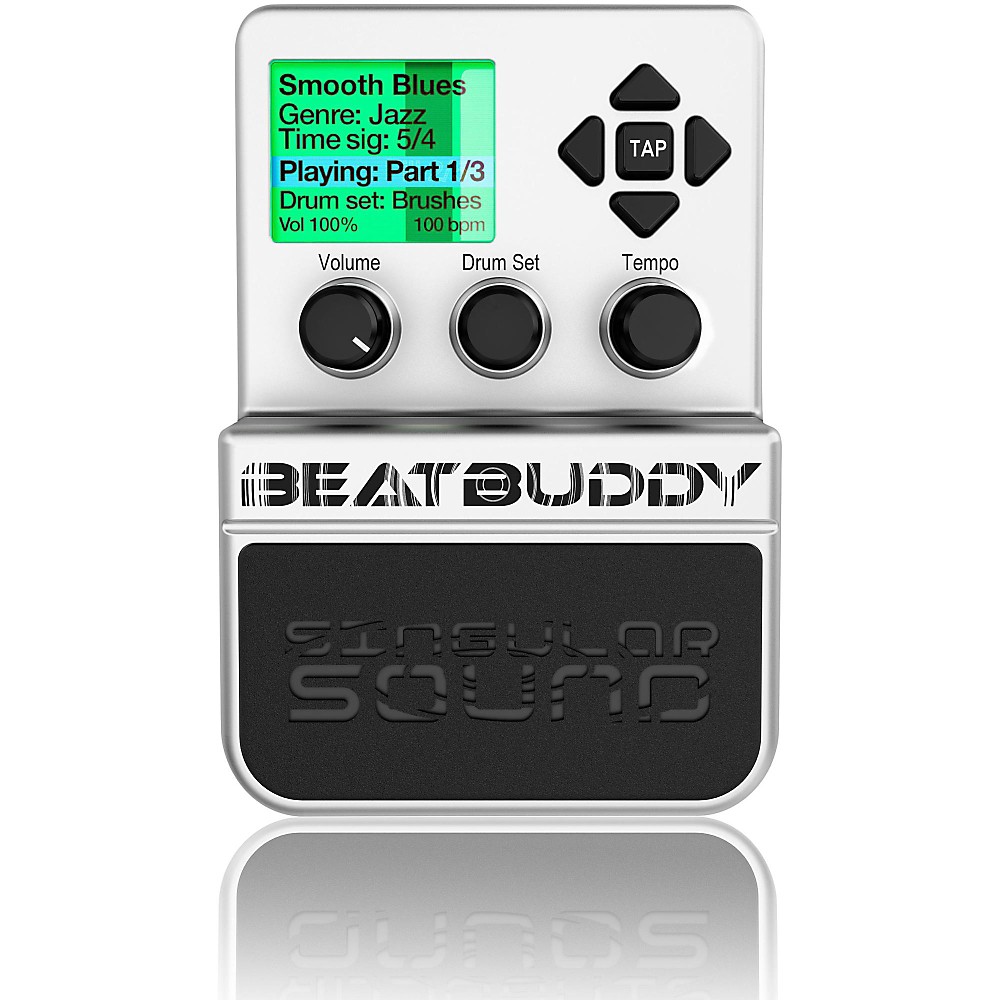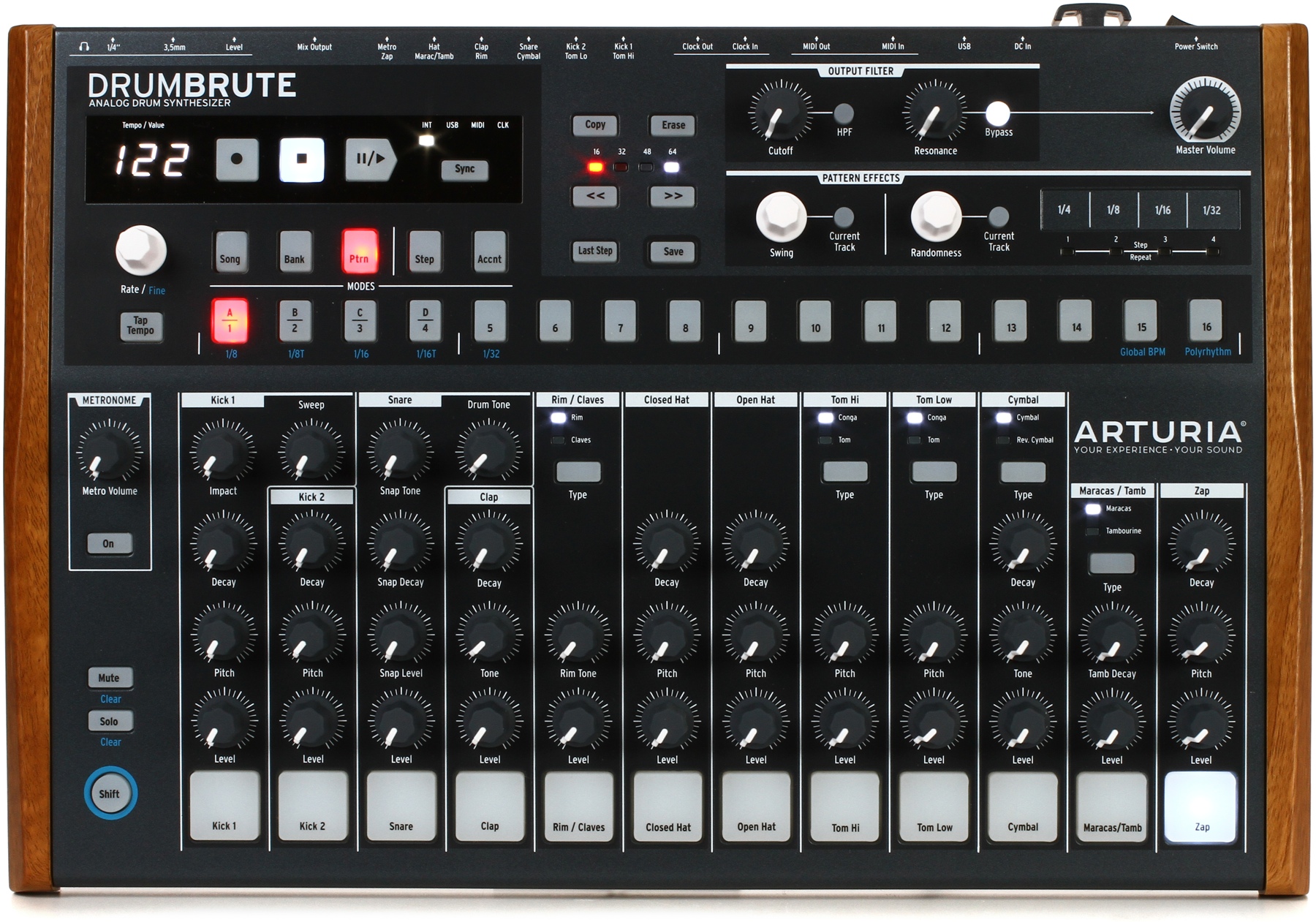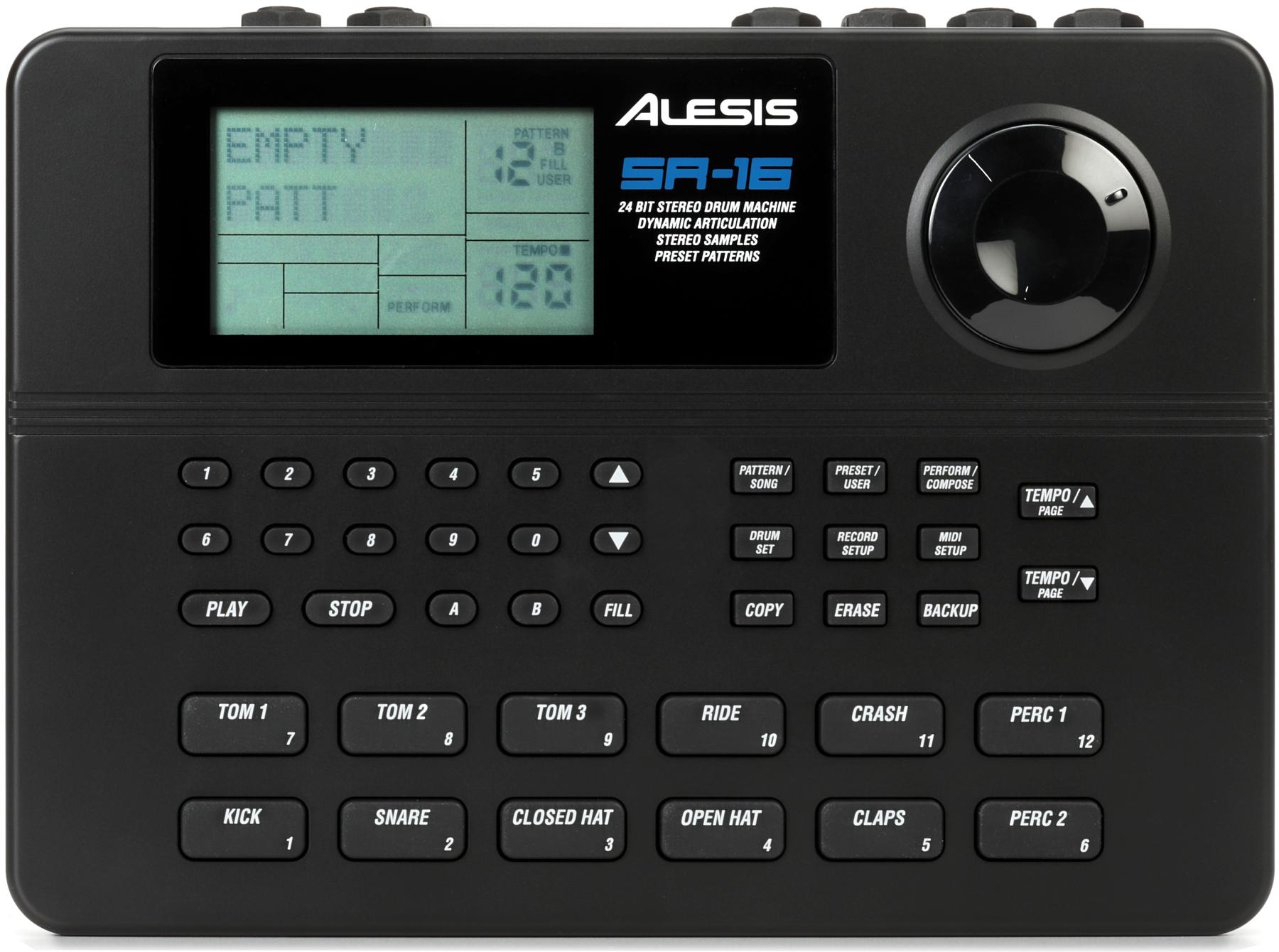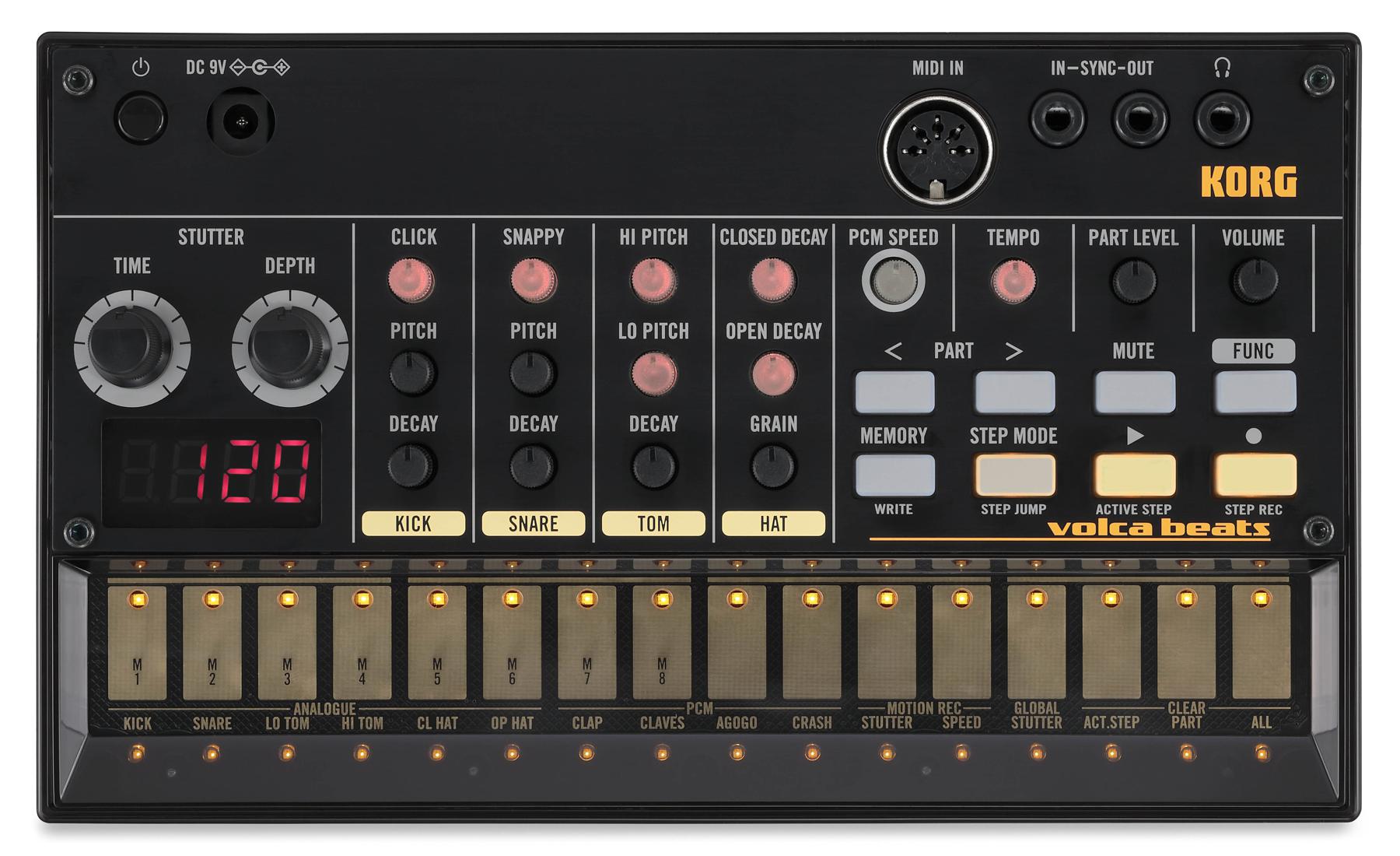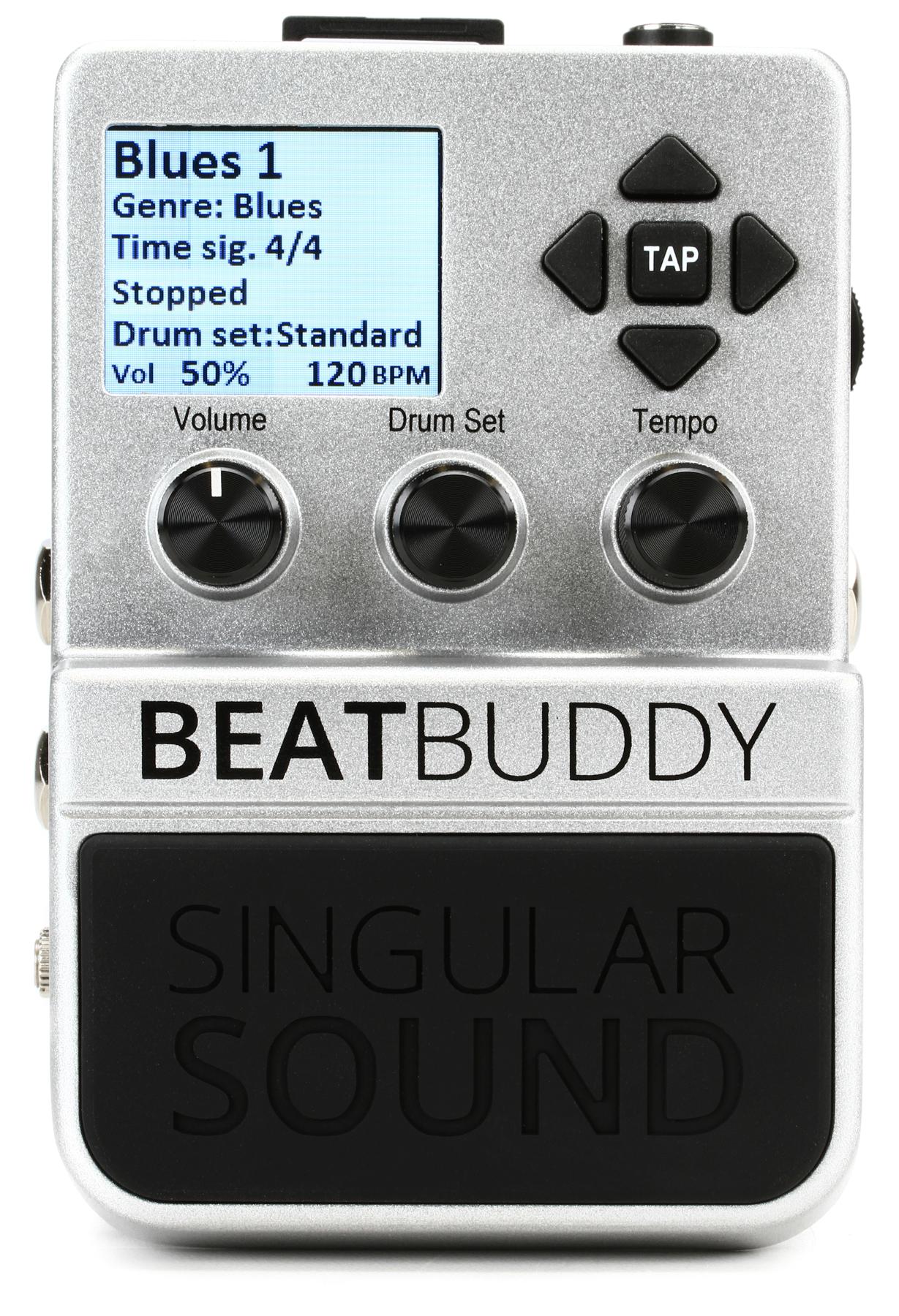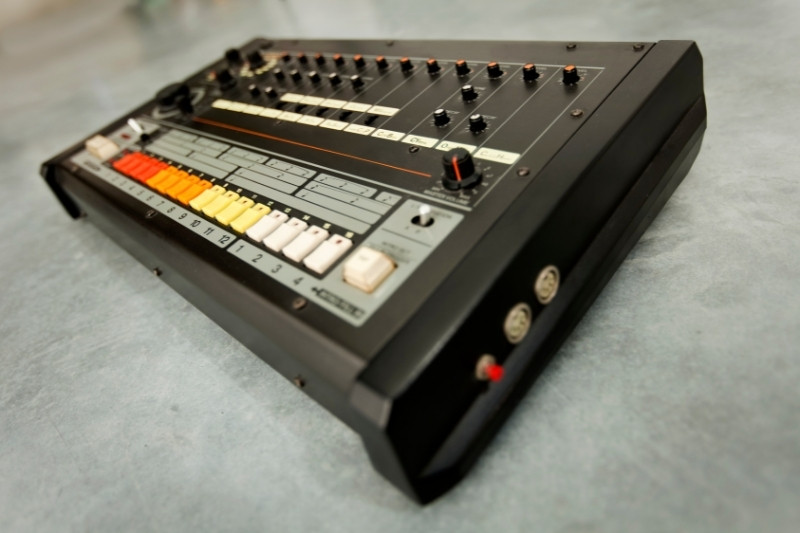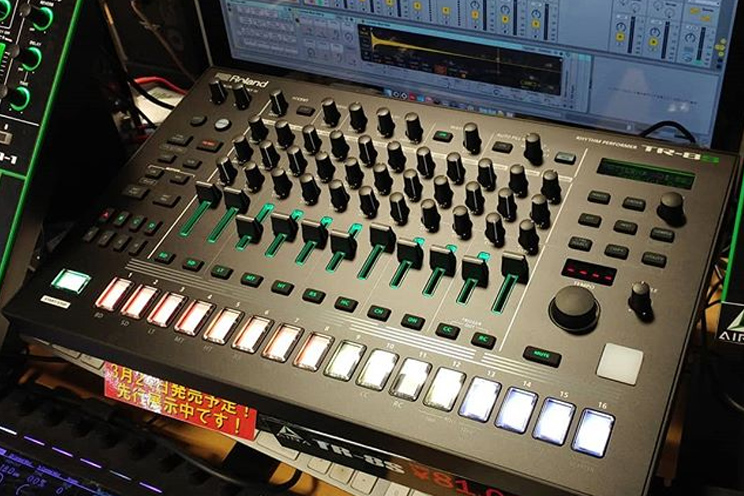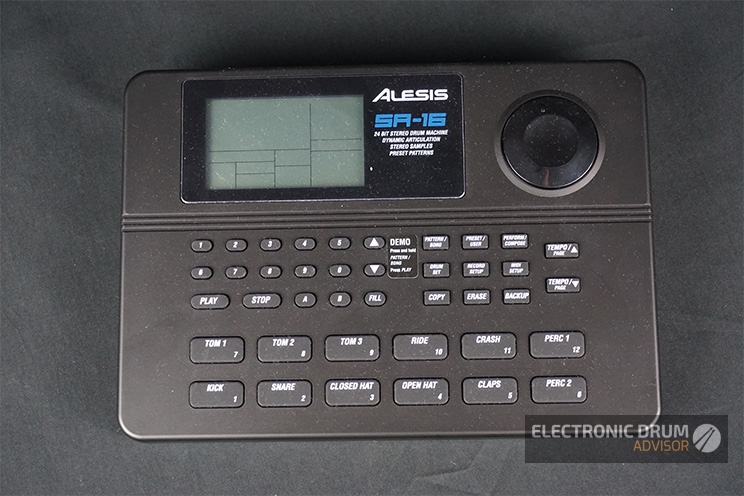The 7 Best Drum Machines of (2024) – Buyer’s Guide and Reviews
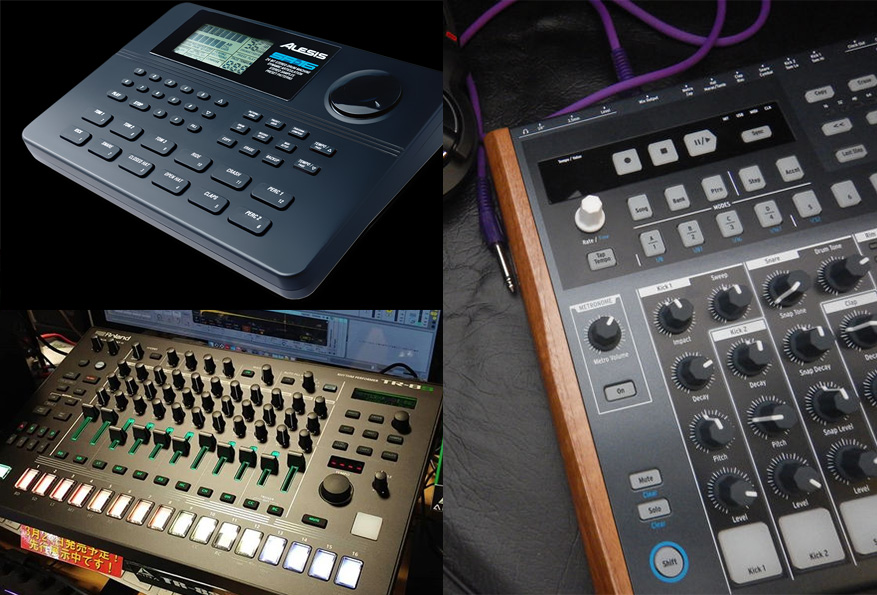
Whether you’re looking for a high-end drum machine or a compact piece of gear that you can take gigging with you, then this is the article for you!
All of the options on this list are hardware-based drum machines that have their own internal sounds. It can be great to have a physical standalone drum machine that you can interact with, rather than doing everything inside your DAW.
I have not included MIDI drum pads on this list. If you want to check out some great MIDI controllers with drum pads, then check out our round-up article on those.
My top recommended drum machine is the Roland TR-8S, a high-end but high-quality drum machine for serious musicians.
My second recommended drum machine is the Alesis SR-16. If you’re on a tight budget, this is a good drum machine to consider.
Contents
- The 7 Best Drum Machines (2024)
- 1. Roland TR-8S Rhythm Performer
- 2. Alesis SR-16
- 3. Teenage Engineering PO-12
- 4. Alesis SR18
- 5. Korg Volca Beats Analog Rhythm Machine
- 6. Singular Sound BeatBuddy
- 7. Arturia DrumBrute
- Buyer’s Guide
- What is a Drum Machine?
- What to Consider When Buying a Drum Machine?
- Playing the Drum Machine Live
- Analog or Digital Drum Machines?
- What is the difference between a Drum Machine and MIDI Drum Pads?
- How can I record a drum machine to my computer?
- Can drum machines be run on battery power?
- What are the MIDI capability on Drum Machines?
- How to connect a drum machine to an amplifier, mixer, or PA system?
- How to connect headphones to a drum machine?
- How to play backing tracks through a drum machine?
- Summary
The 7 Best Drum Machines (2024)
Let’s compare these in more detail.
1. Roland TR-8S Rhythm Performer
The Roland TR-8S is Roland’s flagship drum machine and it follows on from the hugely popular Roland TR-8.
It takes what was great about the original TR-8 and adds a whole lot of modern features such as sample import as well as modern sound effects and editing capabilities.
This machine has an amazing depth of effects that can be added on a channel-by-channel basis. You get more than just drum sounds with the TR-8S, you also get synth-type sounds, so this drum machine could literally be your entire live production setup in certain electronic music styles for example!
Let’s face it, Roland’s offerings are often a little on the expensive side, but when it comes to a drum machine like this, their quality can be difficult to match.
2. Alesis SR-16
![]() The Alesis SR 16 is one of the most popular rhythm machines ever produced. It is a standalone drum machine and has been actively used for twenty-seven years. From its introduction in 1990 to the present time, this electronic drum machine has been developing simultaneously with the electronic music scene.
The Alesis SR 16 is one of the most popular rhythm machines ever produced. It is a standalone drum machine and has been actively used for twenty-seven years. From its introduction in 1990 to the present time, this electronic drum machine has been developing simultaneously with the electronic music scene.
Many people are even surprised that they’re still making these. Oftentimes, all you want is a basic, compact, and easy-to-use drum machine that will suit your needs. The Alesis SR16 is a great choice for this.
You can use the sound as dry tones or pair them with en-suite digital reverbs. There are a wide amount of internal drum sounds available. It is MIDI compatible so you can connect this to other music gear and sync the timing or record externally.
As this was released in 1990, you can expect to get some old-school sounds from this, but classic drum sounds are still heavily in use in many different forms of electronic music, hip-hop, and more. So, this is still very applicable to modern music.
There are 12 velocity-sensitive buttons on the front that you can create drum patterns in real-time using its built-in sequencer. These are Tom 1, Tom2, Tom 3, Ride, Crash, Percussion 1, Kick, Snare, Closed Hi-hat, Open Hi-Hat, Claps, Percussion 2.
You can connect footswitches to the SR16 to start/stop loops and perform other functions. The SR16 is a great, cheap, compact option that has suited the needs of many different musicians.
3. Teenage Engineering PO-12
This might be another surprising option to see on this list. If you’re looking for a cheap drum machine, then the Teenage Engineering PO-12 has loads of cool sequencing and parameter tweaking options then check this one out.
If you get this, you’ll also end up looking like a modular synth guru to all of your friends. It’s battery-powered by 2 AAA batteries (that’s right… that’s all that’s required to power this!).
It has sixteen different sounds, which sound pretty cool and you can sequence these to sound really cool. This device has a much greater variety of sound than you might expect, it contains parameter tweaking knobs that allow you to change the sound (check it out in the video below).
Overall, this is a simple and budget-friendly drum machine.
4. Alesis SR18
The Alesis SR18 is a newer version of the SR16 Drum Machine. It sounds better and has a lot more sounds, though it still works off very similar technology to the Alesis SR16.
If you’re looking for a standalone, compact, and easy-to-use drum machine then this may be a great answer, though, with the money you spend here, you could opt for a more fully-fledged drum machine.
These also come with velocity-sensitive pads, they can be powered by batteries (which is a great advantage) or via AC power. It allows for both MIDI In and Out and you can there are 2 different footswitch inputs (one for Start/Stop and the other for Count/A/B/Fill).
If you want all the benefits of the SR16, but want better sounds and a great variety of them, then check out the Alesis SR-18.
The ASR 18 also comes with a lot more internal sounds as well as 50 internal bass tracks for you to add in bass lines. It also supports up to 32 polyphony voices which are better than the SR 16.
The button setup is a little different from its predecessor, it includes the following, which I think are more suitable and applicable to more modern uses: Tom 1, Tom 2, Tom 3, Crash, Ride, Bell, Kick (kick drums), Snare 1, Snare 2, Hi-Hat Closed, Hi-Hat Middle, Hi-Hat Open.
5. Korg Volca Beats Analog Rhythm Machine
The Korg Volca Beats Analog Rhythm Machine is a high-quality analog drum machine. Using Analog synthesis can take your sound to a whole different level when compared to digital. If you’re producing your music then you should check this one out.
For starters, this electronic drum machine comes with a first-class step sequencer that will turn the editing experience into a seamless music joy.
Also, you can produce the notes you need to make music on this device with 16 different step keys. At the same time, you can follow the timing of every note, to stick with the rhythm and tempo of the track.
Regarding the PCM sound engine, its greatest benefit is the option to generate sounds like Claves, Agogo, Clap, and Crash, which don’t fit with the analog synthesizer sound. Also, the ability to produce the appreciated lo-fi sound that was popular in the 1980s makes the Korg Volca drum a true blast from the past.
The Korg Volca Beats can be loaded with your own rhythm samples, since it allows recording up to 10 instruments, creating distinctive polyphony. A specific characteristic of this rhythm machine is its unique sound. It can be explained as a bit brassy, bassy and blaring. Therefore this may be more suitable for lovers of techno.
This device’s portability makes it a great choice. It can be powered by batteries as well as AC power. Also, its integrated speakers are a great benefit.
6. Singular Sound BeatBuddy
Want a drum machine but your hands are too busy playing other musical instruments? Check out the Singular Sound BeatBuddy, it’s a drum machine that’s operated like a guitar effect pedal.
The sound quality here is very good, the build quality is excellent, and it has a generous amount of different built-in sounds. You can add your patterns and rhythms, and download other ready-made songs.
It’s difficult to get more compact than the BeatBuddy, put it alongside your other pedals and introduce a whole new rhythm section to your playing! There is also an even more basic version, which is called the ‘BeatBuddy Mini’, this has a more limited amount of features, but is still decent.
You can also buy a separate dual footswitch that can be connected to this. This allows you to do some extra stuff, such as drum pauses and emphasized hits.
7. Arturia DrumBrute
The Arturia DrumBrute Impact is another Analog drum machine for people that are serious about music production. It provides seventeen different fully analog percussion instruments and includes a fantastic sequencer and an amazing depth of effects.
It has classic drum sounds with a very modern interface and effects. If you’re looking for realistic acoustic drum sounds then obviously this is not what you should get, but if you want great, tweakable, modulating analog sounds then this is a great option.
It includes a great amount of connectivity, MIDI In/Out, and Sync, it includes 12 individual outputs, which is amazing when recording or sending to a mixing desk for live performance. However, they use 1/8 inch connectors rather than 1/4 inch, which can be annoying as you would need to get either connectors or separate cables.
This is also high on our list for the top pro pick as the best drum machine. Check out this video below to see it in action and learn about many of its other features:
Buyer’s Guide
Electronic drum machines are an extremely popular tool in the arsenal of producers, DJs, and live performers.
These are actively used in musical styles that require solid drum rhythms. They are also favored by minimal music outfits and solo artists that do not have a drummer. These devices are also a lot more practical to transport around than a physical drum kit.
Despite the explosion in the use of digital audio workstations and software-based instruments for live performance (such as Ableton Live or MASCHINE), standalone electronic drum machines still hold a very strong position in music scenes.
In addition to this, some drum machines nowadays (such as the Native Instruments and AKAI models below) are controllers for software-based instruments. We’ve reviewed the top electronic drum machines on the market.
What is a Drum Machine?

A Drum Machine is a standalone electronic musical instrument that can play drum samples and synthesized drums in the form of beats and patterns.
Drum machines come in many different forms, starting with entry-level (beginner) models that allow the users to play a set of internal sounds and sequence them into their own playing patterns. Higher-end models tend to have a lot more effects sequencing capabilities and more options to communicate with music software such as DAWs.
Drum machines generally have buttons and pads, where the producer or player can play these live. They can ‘finger drum’ these beats and layer the drum beats on top of each other and build up the sequencing of drum sounds.
Drum machines have had quite a large impact on many different musical genres. For example, the Roland TR-808 had quite a large impact on dance music, and you can even hear that today in many different genres.
The 808 has lasted well beyond the original device. If you open up any modern music software, you will see an 808 drum machine replica, or something similar. You can hear this type of drumbeat in many different forms of dance and electronic music and hip-hop.
The TR-909 was also introduced by Roland in the early 80s, and this had quite a large impact on other forms of electronic music such as house music and techno.
These were all synthesized drum sounds, therefore they were not actually real drum samples. Later models started to use actual pre-recorded samples of drums. This added a more realistic element to the sounds and would allow them to sound a little bit more organic and less ‘digital’.
Over the last 20 years, music producers have slowly been moving towards virtual drum production studios, such as using drum vst plugins, instead of using drum machines. However, there are still many supporters of drum machines, particularly those that like to have physical hardware to play the feats.
Drum machines are ‘standalone’, which means you can bring them around without you having to use a laptop or tablet. They are generally more reliable and more robust than using computers.
What to Consider When Buying a Drum Machine?
Among a few things to consider before buying a drum machine like the quality and sound, of course, you should also pay close attention to the price (budget) and the portability of the drum machine.
Budget
The price ranges of drum machines vary greatly. If you’re looking for an entry-level model that can just play a few pre-recorded samples or internally synthesized sounds, then you can get one at a pretty affordable rate.
This should also allow you to do some basic sequencing, and allow you to output as to a speaker system or headphones. Generally, you should also try and look for MIDI capability if you want to leave the possibility open for it to trigger external samples in a DAW.
If you’re looking for much-improved sequencing capabilities, custom sampling (sampler), and many different types of internal effects and modulation options, then you’re going to need to fork out a higher-end option.
If you want this to be a live instrument with fluid and changing patterns, then the pro options will be the ones that you should be considering.
Just make sure to keep in mind what your budget is for your drum machine because if you only have a low amount of money to spend, then it might be a better option to invest in a MIDI drum pad, which we will talk about later in this article, instead of an affordable drum machine.
This is because you can configure your sounds in the way you want, but this also comes with the cost of not being a standalone device and that you will have to connect it to a computer.
Portability
The sizes of these drum machines vary quite a lot. For example, the teenage engineering one mentioned is extremely lightweight. The Alesis SR-16 is something that you could carry around very easily.
Whereas, the higher-end options are usually bigger pieces of kit. Although are still quite compact, they will not be as easy to carry around with all of your other gear.
So, if you want something that will fit in a small case then you will need to get a suitably compact drum machine. Make sure to look at the videos above and get a good idea of the size and dimensions of each drum machine.
Playing the Drum Machine Live
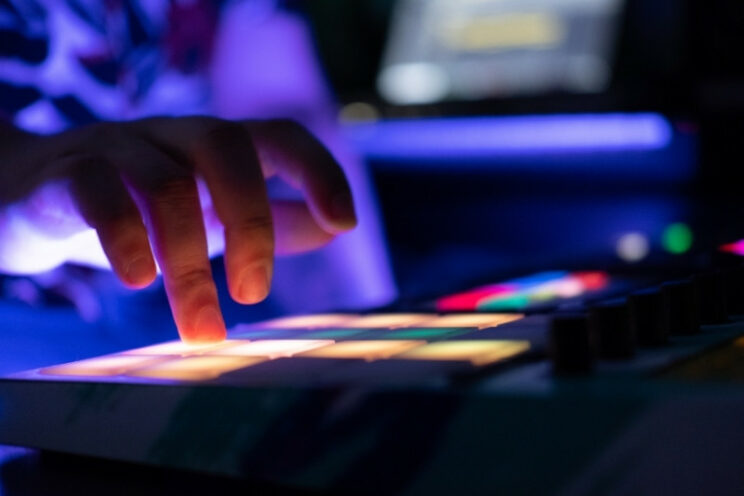
Drum Machines can be used for live performances, you can easily hook them up to a PA system or amplifier. Further down in the article, we explain how you can do this.
Therefore, a real benefit of drum machines is the ability to play them live as a standalone piece of electronic music gear. You can also MIDI sync the internal clocks of the drum machines to sync exactly with your other music gear. This is a very useful feature and it will make sure that you stay on time.
However, you should also think about the actual features that you want in your drum machine to make it so that playing live is a great experience. If you want something very basic then even the most simple drum machine will work very well.
But you might want to fluidly change effects while you were playing, you might want to introduce lots of different types of sounds, and you might also want to use custom sampling. In this case, then you should try and opt for a higher-end option if you can afford to do it.
Also keep in mind, the size and performance of the velocity-sensitive pads on the items, and how easy these will be to play in poorly lit conditions, or when you’re under a little bit of pressure. This will help you make sure that your beats are in-time, and that you enjoy playing it live!
Analog or Digital Drum Machines?
An analog drum machine generates all the sounds internally via its hardware, as opposed to through digital sampling or digital synthesis.
Analog synthesis generally gives a warmer and fuller sound, and it is often favored amongst pro producers looking for the best sound possible. However, digital sampling and synthesis have improved so much that the barriers have lessened, year on year.
The analog versus digital debate is something that will continue for many years to come. So we will not get too involved with it, but if you want to check out an analog drum machine then check out the Korg Volca Beats is an example of this. However, the drum machine itself is a little bit limited.
There has been quite a revival of analog drum machines, so there are plenty of other ones available online that you can check out.
The analog synthesis relies solely on resistors, transistors, capacitors, and other components to generate the drum sounds. Analog synthesis is often viewed as a highly favorable option because it gives more authentic, warm sounds with very subtle random overtones and elements can be very difficult to element using alternative means.
Digital drum machines come in two flavors: They either playback samples or generate the sounds using digital synthesis. Digital synthesis often tries to emulate analog synthesis as much as possible, but can never fully emulate the analog sound. Samples can be either recording of drums, they can also digitally synthesize the beats (i.e. like a soft-synth), or they can be recordings of analog synthesis!
What is the difference between a Drum Machine and MIDI Drum Pads?
Drum machines (such as all 7 options mentioned at the top of this article) are standalone electronic instruments that often create classic type sounds. This can often be achieved through the use of digital or analog synthesis, as well as using stored samples. Hardware drum machines have audio outputs that can be connected directly to a mixer or amplifier so that you can hear the sounds.
MIDI drum pads are basically MIDI controllers that need to be connected to music software (such as Ableton, Cubase, Logic, GarageBand, etc.) or other music gear. If you already know how to use music production software then these can be a great option for you because they are often much cheaper and would need to be recorded separately.
If you’re interested in checking these out then check out our article on the best MIDI drum pads. ![]() The Akai Professional MPD218. Akai is a very well-respected brand in music production.
The Akai Professional MPD218. Akai is a very well-respected brand in music production.
If you opt for this MIDI drum pad, you can count on 16 thick, conveniently organized MPC pads. Moreover, the Akai Professional MPD218 comes with 6 knobs and 48 pads altogether, which can be accessed through 3 banks.
Also, the pad controllers are arranged in a player-friendly way, so that the arranger can smoothly finger drum while making their own music.
Because it’s a MIDI controller, you can trigger almost any sounds on this, from drum machine sounds to bass lines, digital drum kit sounds, old school sounds, synths, pads, vocal lines, and anything else you can think of!
As for the power supply, this drum machine can be directly connected to a computer via a USB cable. There is no need for a separate AC adapter.
The guys from Akai have bundled a plethora of free software packages along with this, including the Akai Pro MPC Essentials, Big Bank Universal Drums, Ableton Live Lite, and SONiVOX Big Bank Cinematic Percussion from the Akai website.
Further, the Akai Professional MPD218 is compatible with all the major operating systems, so that you don’t have to install any additional drivers while connecting this electronic drum machine to your computer.
Note: this device is a MIDI controller and must be used in conjunction with a DAW. However, the software is bundled with the device.
How can I record a drum machine to my computer?
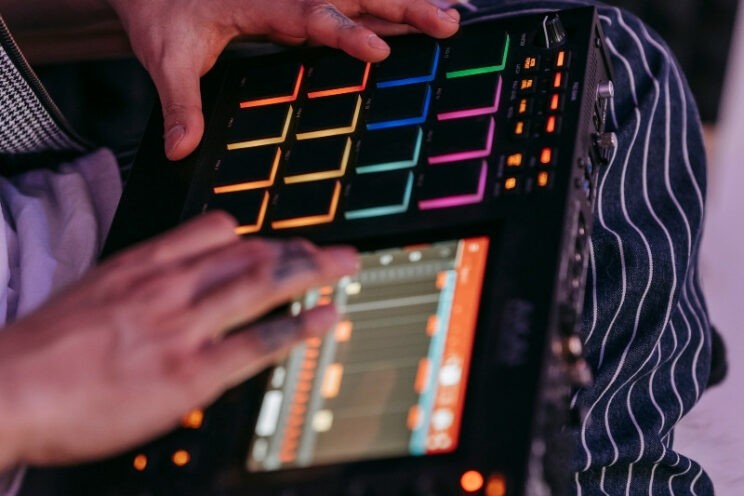
It’s quite easy to record audio from a drum machine to your computer, though you need an audio interface. Alternatively, you can hook the MIDI signals up to your music production software.
This all uses almost the exact same process as recording electronic drums, so be sure to check out our article on how to record electronic drums on your computer.
Some of the best drum machines act as their own audio interface and can transfer multi-track audio feeds to a DAW (a great feature), this is available on the Roland TR8-S for example.
Can drum machines be run on battery power?
Some do and some don’t. Make sure to check the specs before buying.
If you’re planning to use the drum machine for quick setups and street performing, then having a battery-powered device can be a big advantage.
What are the MIDI capability on Drum Machines?
Most drum machines have MIDI In/Out capability as well as MIDI Sync capability.
MIDI In means that it can accept MIDI signals from other devices. You could trigger sounds from another piece of gear in this case.
MIDI Out means that you can trigger sounds and actions on external gear or music software. For example, hitting a button on your drum machine could trigger a synth loop on Ableton live!
MIDI Sync allows your drum machine to stay in time with other music gear, or be the ‘master’ click that other music gear stays in time to.
That’s just a basic overview of how these functions can be used.
How to connect a drum machine to an amplifier, mixer, or PA system?
Drum machines generally have main audio outputs that accept 1/4″ jack connections (also known as guitar cables and instrument cables). They usually have main left and main right outputs, if you want to get a stereo signal. If you want to go for a Mono signal, often you just need to have one 1/4″ cable out of the left output.
How to connect headphones to a drum machine?
Most machines will also have a separate headphone jack, which will allow you to monitor separately. Usually in the form of a 1/4″ inch jack connection. If your earphones use a 1/8″ connection then you can buy an adapter.
How to play backing tracks through a drum machine?
Drum machines can also have an Aux or auxiliary input. This will allow you to feed through audio from a phone or other music player which will allow you to play through the music.
As with most different types of electronic music gear, the features of aux feeds will vary greatly. In some cases, it might just feature the source and you will only be able to control the volume from your sound source.
In other cases, you will be able to control the volume directly on the device. Make sure to read the specifications of your drum machine beforehand.
This is great for casual use, but be careful when using the aux signal if you’re planning to play it through a speaker system for example. It’s usually better to balance these signals when using a mixer. The sound source of your aux signal will also vary. For example, the music output from a standard phone might sound bad, especially if you are introducing electrical noise by charging the phone at the same time!
Summary
Before deciding on the best drum machine for you, make sure to ask yourself are you want to get a standalone hardware drum machine or if you just need a MIDI controller that could be hooked up to your music production software!
My high-end pick is the Roland TR-8S which has practically everything you could need in a drum machine and sequencer. If you’re serious about making music then you should check this out.
All of the drum machines above are great options. If you’re on a budget and want something compact, then the Alesis SR-16 is a really decent option. It’s a tried and tested machine that has been popular for many years. It’s still one of the best drum machines for entry-level purposes.
Featured image – Alesis SR16 image Courtesy of Alesis. Roland TR-8S Image by Kazuhisa OTSUBO from Tokyo, Japan [CC BY 2.0 (https://creativecommons.org/licenses/by/2.0)]

